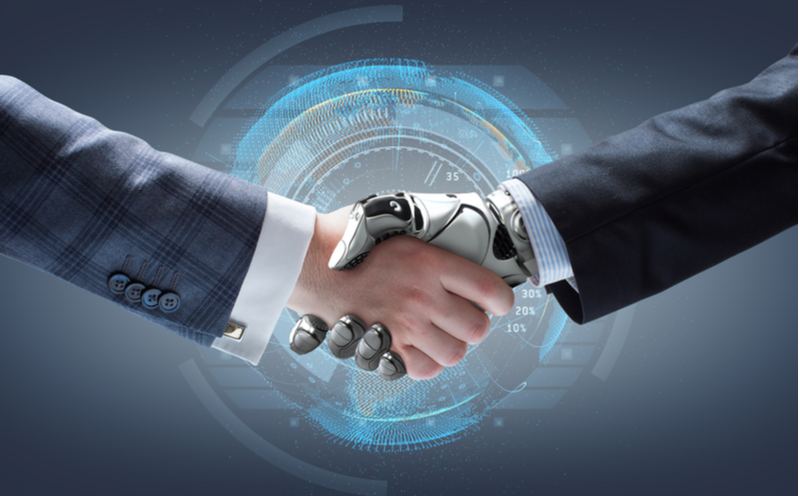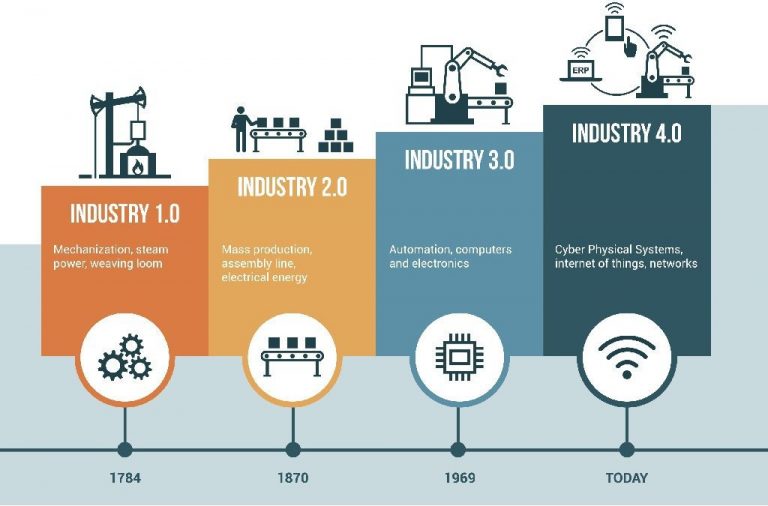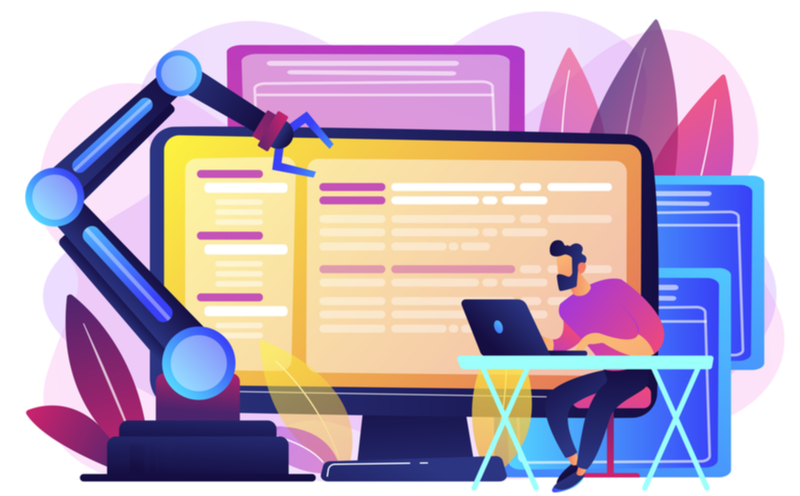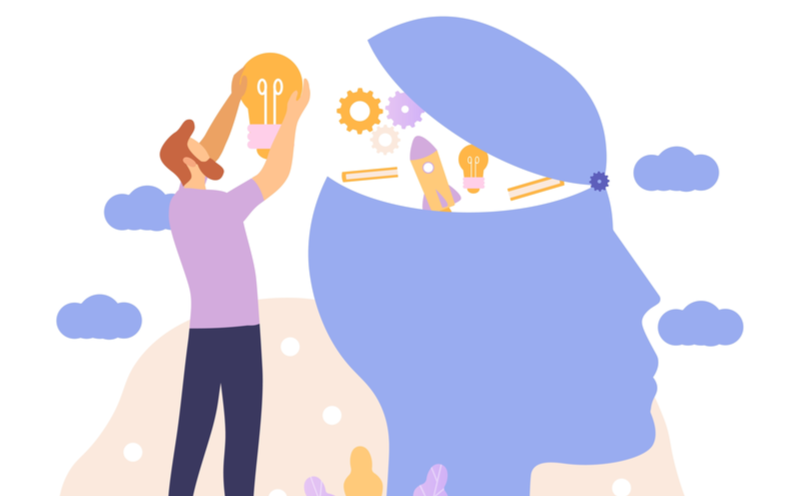Will the Fourth Industrial Revolution Impact Tech Jobs?

In this article
- What Is the Fourth Industrial Revolution?
- Automation-Compatible Jobs Will Alter the Nature of Work
- Could Upskilling Workers Combat the Negative Effects of Automation?
- Education Models Are Pivoting Towards Personalized Learning To...
- Workers, Too, Are Feeling the Pressure — And Investing in...
- Upskilling Will Become Essential to a Sustainable Economy
After the real estate tech startup he was working for went belly-up during the pandemic, Reagan Tatsch found himself at a crossroads. Shuttered college campuses had transitioned overnight to online learning, and the company lost its key market: students who were searching for off-campus living accommodations. Shortly before receiving the news that he was out of a job, Tatsch, who worked in marketing operations, had started teaching himself data analytics on the job.
He loved the fact that working with data enabled him to solve problems he’d never encountered before while empowering better business decision-making.
“I had just recently started getting exposed to data, and I wanted to go further down that path,” said Tatsch, “so I took the opportunity to explore that a bit further, and that’s when I found Springboard.”
Tatsch is one of the numerous Springboard graduates who made a major career pivot following a pandemic-related job loss. While the notion of a “future-proof” job is over-optimistic at best, given the breakneck pace of technological development, many workers agree that the pressure to acquire digital skills is mounting.
By 2022, 54% of Americans will require significant upskilling due to automation and AI, according to the World Economic Forum—a phenomenon the global NGO has dubbed the “Fourth Industrial Revolution.” The WEF even pegged digital upskilling as a “crucial part of sustainability” because it “ensures continuity of workforce for society.”
A slew of Fortune 500s including Verizon, JPMorgan, Accenture, PwC, Amazon, and Deloitte have launched million and billion-dollar programs to help workers upskill. The move is paying off: a PwC study from 2020 found that companies with the most advanced upskilling programs saw three times the improvement in innovation.
What Is the Fourth Industrial Revolution?

An industrial revolution represents a period of rapid technological advancement that changes the way we live, work, and play. The First Industrial Revolution began in the 18th century, when agricultural societies embraced electricity, the transcontinental railroad, and other inventions that allowed goods to be made by machines rather than by hand. Over a century later, the Second Industrial Revolution introduced mass production—consumer goods were produced more cheaply and quickly, news spread faster via newspapers and radios, and mass transportation made it easier to get around.
Like its predecessors, the Fourth Industrial Revolution presents more of a gradual transformation than a quantum leap, but it’s happening much faster than the ones before it. According to WEF, the velocity, scope, and “systems impact” of the transformation we’re seeing today merits the invocation of a “Fourth Industrial Revolution,” rather than treating it as an extension of The Third Industrial Revolution, which was marked by with the advent of the internet, renewable energy, and basic automation starting in the 1950s.
Cloud service providers like Amazon Web Services and Azure have made it possible for just about anyone to access unprecedented computing power and storage capacity—thereby empowering the average joe to build machine learning models using terabytes of data, mine cryptocurrencies, generate deep fakes, and stay connected using 5G networks. What’s more, billions of people are connected by mobile devices, creating breakthroughs in IoT, robotics, and autonomous vehicles.
Meanwhile, Wall Street and Big Tech are locked in an arm’s race to materialize a “metaverse” that could blend the virtual and physical realm à la the 2018 sci-fi film Ready Player One. On top of that, businesses across every industry are taking advantage of AI, quantum computers (which are faster and better at solving problems than supercomputers), and big data to eliminate inefficiencies and streamline their operations. In some cases, “inefficiency” is a salaried human worker who, unlike a robot, is entitled by law to minimum wage, rest breaks, and to be free from discrimination.
As offices and factories shuttered during the pandemic to reduce the risk of contagion, millions of laid-off workers discovered that their former employers had quietly replaced them with droids. Toll collectors at the New York State Thruway were supplanted with a cashless tolling system. Robot butlers, which have been in ascendancy at four- and five-star hotels since the mid-2010s, became a godsend to beleaguered hoteliers desperate to win back guests who were leery of travel.
Fast food chains struggling to hire workers during the Great Resignation turned to automated voice systems to take orders. One Ohio-based fried chicken chain found that automation boosted sales—unlike its human counterparts, the system, developed by Intel and voice recognition firm Hi Auto, never failed to upsell customers on fries and a drink.
While it’s easy to assume that the most automation-ready jobs are low-skilled, manual roles, a slew of white-collar roles have been earmarked as “compatible with automation”—AKA ripe for human-machine interaction. This means certain tasks can be automated for greater efficiency.
In August 2020, robotics company Boston Dynamics pioneered a four-legged, dog-inspired robot named Spot that could measure a patient’s vital signs in a bid to shield medical assistants and nurses from potential COVID-19 transmission while admitting patients to a hospital or clinic.
Automation-Compatible Jobs Will Alter the Nature of Work

A 2021 report from real estate tech firm CommercialCafe designated certain roles as “at least 50% compatible with automation.” This includes jobs such as library technician, procurement clerk, and tax preparer, for whom rote tasks like data entry, file exchange, and cleanup can be automated. Jobs least compatible with automation were those in the education sector—high-touch teaching positions such as preschool teachers, postsecondary art, music, and drama teachers, and nursing instructors.
Bear in mind that automation-compatible jobs aren’t necessarily at risk of disappearing; but it does mean that workers in those roles will need to adjust to new ways of working: letting the machine complete “mindless” tasks while focusing on more high-value work.
In data science, no-code and low-code machine learning tools have made it easier even for those with programming knowledge to build machine learning models without having to write as much code.
“Some of these solutions are plug-and-play; you just dump your data in, and you don’t need to be extra-proficient in coding,” said Dipanjan Sarkar, a data scientist at SIT Academy in Switzerland and a mentor for Springboard’s Data Science Career Track. “By using these tools you can focus on doing what you do best—solving problems.”
Meha Jain, a mentor for Springboard’s Software Engineering Career Track and a software engineer at Now Buildings, a wholesale shed supplier based in Australia, is currently working on a product configurator that will enable customers to create their own 3D renderings for an industrial or farm shed, thereby eliminating the need for a drafter.
“Right now we have a drafter who does the renderings,” she explained. “It takes them several days to get the job done. But I’m creating an application where you can provide inputs and generate a 3D model from AutoCAD. So it’s complete automation.”
If you’re wondering what the future of work will look like and your role in it, PwC offers a useful framework for the three levels of AI in its report Workforce of the future: The competing forces shaping 2030, which gives some idea of what human-machine interaction will look like for jobs that can be partially automated.
- Assisted intelligence: “Improves what people and organizations are already doing.” An example is GPS navigation in a car, which offers drivers directions and adjusts to road conditions.
- Augmented intelligence: “Helps people and organizations do things they couldn’t otherwise do”. Examples include parsing terabytes of data or automatically triaging cybersecurity alerts based on historical incidents.
- Autonomous intelligence: “Establishes machines that act on their own.” Examples include self-driving cars and smart manufacturing robots.
Could Upskilling Workers Combat the Negative Effects of Automation?

In 2019, Amazon announced a $700 million initiative to boost the digital skills of its workers. Other corporations including Nationwide, IBM, and Home Depot are doing the same. Exelon, a utility company, implemented a training approach called “co-investing” which means the company funds in-house training but employees must complete it in their off-hours.
According to PwC’s Global Digital IQ Survey, 86% of top-performing companies reported that digital training programs boosted employee engagement and performance.
In fact, upskilling can be a crucial component of employee retention. Companies are hemorrhaging workers during the Great Resignation, many of whom leave because they’re looking for a change or better pay.
Springboard alum Jack Mayer started his career at Whitepages as a fraud analyst. After participating in a company hackathon, he decided to learn how to code. After completing the Software Engineering Career Track at Springboard, he convinced his manager to let him transfer to the engineering department.
“If I didn’t have such a good working relationship with my coworkers, I don’t think I would have been given the opportunity,” said Mayer, who has been with the company for nearly three years. “You have to be adamant about it, be passionate, and show people that you are willing to put in the work.”
According to a survey, 63% of employees said a lack of career development opportunities would be enough for them to leave their current employers. The same survey found that 77% of employees feel that developing their careers within their current company is solely on them. Companies have a major role to play in instilling a culture of continuous learning, designating time during the workweek to acquire new skills, and guiding employees towards the skillsets the company will need in the future—which should be part of any good succession planning strategy.
Unions may play a role in ensuring employees receive training opportunities, even those who are not on career paths that traditionally warrant retraining, otherwise, they’ll be left behind.
PwC offers a Digital Accelerators program that aims to boost the high-tech skills of its workforce. The company also launched a Digital Fitness app which is available not only internally but in public app stores. The app offers bite-sized tutorials in 60 subject areas, including blockchain, design thinking, drones, robotics, IoT, AI, cybersecurity, and more.
In 2020, LinkedIn set up a training hub in partnership with Microsoft and GitHub offering free training resources for the top 10 jobs with the greatest number of openings. The job openings that saw the largest surge, according to LinkedIn’s Economic Graph data, were the following:
- Software developer
- Sales representative
- Project manager
- IT administrator
- Customer service specialist
- Digital marketer
- IT service/helpdesk
- Data analyst
- Financial analyst
- Graphic designer
Microsoft recently expanded its digital alliance with the city of Houston to expand “Accelerate” a new program designed to address economic recovery through skilling both underserved economies and reskilling the many Americans impacted by COVID-19. In partnership with corporations, K-12 school systems, and higher ed providers, Microsoft is developing a plan for professional development and addressing the equity gap across the community.
Companies are starting to recognize the importance of instilling digital literacy at the grade-school level. The Microsoft initiative will bring the Microsoft Imagine Academy Learning Paths to Houston schools, with content and industry certifications mapped to student skill development. Additional programming includes LinkedIn workshops, DigiCamps and DigiGirlz camps to help young people plan their future, identify the skills they need to reach their goals, and connect to programs that will help them get there.
“Ultimately, it is the worker who needs to take ownership of their learning when provided with the resources to grow and develop,” said Kwok.
Education Models Are Pivoting Towards Personalized Learning To Prepare the Future Workforce

As major companies including Google, Tesla, Netflix, and IBM move from credentials-based hiring to skills-based hiring (selecting workers who have the required competencies, regardless of how they acquired their skills), it’s becoming increasingly clear that the modern workforce must undergo continuous training and retraining to remain employable.
In a new report, the International Labor Organization calls for “recognition of a universal entitlement to lifelong learning and the establishment of an effective lifelong learning system.” In other words, nations should recognize that learning cannot end after high school or college.
“Lifelong learning is the mindset that we live in an ever-changing world and we will evolve with it,” said Patty Kwok, director of career outcomes at Springboard. “Employers and educational institutions need to provide the right opportunities for effective learning.”
In Switzerland, for example, a teenager can enroll in three- or four-year apprenticeships while simultaneously completing their schooling, and end up with a nationally recognized, portable certification and a job from their sponsor. In Germany, Austria, Denmark, Norway, and Switzerland, between 30-70% of high school students participate in these “dual” vocational education and training (VET) programs.
Surveys show that rather than feeling fearful, people are eager to embrace the digital-first future of work. PwC surveyed over 10,000 members of the general population in China, Germany, India, the UK, and the US to gauge their sentiments around AI and automation. Thirty-seven percent identified with the statement “Excited—I see a world full of possibility,” while 36% selected “Confident—I know that I will be successful.” Just 18% of respondents said they were worried about the future.
“For students, it’s not just about acquiring knowledge, but about how to learn,” Blair Shepard, global leader, strategy and development at PwC, is quoted as saying in the report. “For the rest of us, we should remember that intellectual complacency is not our friend and that learning— not just new things but new ways of thinking—is a life-long endeavor.”
Longer life expectancy means older workers will need to work longer and update their skills, making “retooling the norm.” The report also notes that depleted fossil fuels and extreme weather associated with climate change call for accelerated technological innovations to solve pressing global challenges.
More and more would-be students are turning to bootcamps and industry certifications as a fast and relatively inexpensive means of acquiring new skills. In 2020, 44,254 students graduated from or attended a bootcamp—a 30.32% increase since 2019. The average tuition for a bootcamp was $11,727.
The employment-driven value proposition of bootcamps—career coaching, and in some cases mentorship, and portfolio-ready coursework—reduces the perceived risk of embarking on a career change or pursuing further education in an uncertain economy.
Competency-based education, sometimes referred to as “personalized learning,” measures skills and learning rather than time spent in a classroom. Students progress through courses as soon as they can prove they’ve mastered the material, rather than advancing only when the semester or term is over.
More and more universities are starting to offer competency-based degrees for traditional and non-traditional learners alike, marking a shift from what the Chronicle of Higher Education calls “assembly-line education.”
“Industrial education systems are rooted in seat time: the amount of instruction students receive,” writes Arthur Levine. “The programs assume that all students can learn the same things in the same period of time.”
Self-paced education makes it easier for students to balance their studies with other responsibilities and rewards fast learners for completing work expeditiously. Some programs also allow students to earn credit for knowledge acquired through work, life experiences, or prior education, thereby driving down the cost of education.
Western Governors University, Southern New Hampshire University, and Alverno College are just a few of the institutions that offer competency-based degrees at scale.
“For more than a century, our higher education system has evolved very little, even as the nature of work has shifted dramatically,” WGU President Scott Pulsipher said in a press release. “A system that was designed to serve learners well in the post-industrial area, today has resulted in widening gaps relative to work, and significant disparities in access and attainment.”
Workers, Too, Are Feeling the Pressure — And Investing in ‘Digital Upskilling’

After surveying 33,000 people around the world for its latest annual trust survey, the global communications firm Edelman found that 59% of employees worry about not having the training and skills necessary for a well-paying job, and 55% worry that automation and other tech will make their job obsolete.
However, upskilling society won’t come cheap. The World Economic Forum estimates that retraining the 1.37 million workers in the US whose jobs are threatened will cost US$34 billion—or US$24,800 per person.
Tech workers are feeling the crunch, too. The pandemic has given rise to a phenomenon known as “digital upskilling,” as laid-off workers scramble to acquire in-demand tech skills and pivot into new careers.
Springboard alum Bart Teeuwen is one of many mid-career professionals who felt that pressure, even though he remained employed during the pandemic. Teeuwen spent several years working as a business analyst in sales and marketing. He even ran his own marketing consultancy on the side, Theo and Associates Consulting, in the Bay Area. Over the years, he found that more and more employers required business analysts to be data-literate, so he decided to enroll in Springboard’s Data Analytics Career Track in order to remain competitive in the job market.
“In the Bay Area, there’s a high demand for data analysts, but I saw a shift happening,” said Teeuwen, now a global analyst for talent intelligence at Meta. “I didn’t want to stay behind, so I decided to pursue data analytics in my free time and see if I can implement it in my next role. I think it’s important as we move towards the future that analysts know how to work with data.”
Upskilling Will Become Essential to a Sustainable Economy

Whether these emerging technologies should be seen as an opportunity or a threat is largely a “glass half-full” or “glass half-empty” conundrum. Optimists believe AI could create a world where humans spend more time engaged in high-level creativity and decision-making while machines do the heavy lifting to process, analyze, and evaluate data.
Pessimists believe machines will eventually automate away the majority of jobs, leaving humans without meaningful work or a living wage. Arguably, both viewpoints represent the extreme, and the reality is likely to play out somewhere in the middle. A full 73% of respondents in the aforementioned PwC survey think technology can never replace the human mind.
“AI-based machines are fast, more accurate, and consistently rational, but they aren’t intuitive, emotional, or culturally sensitive,” David De Cremer and Garry Kasparov wrote in Harvard Business Review. “And it’s exactly these abilities that humans possess and which makes us effective.”
Either way, the growing prevalence of AI in our day-to-day work necessitates that workers understand how these machines work (at least on a theoretical level) and how to work in concert with them to reap the benefits of human-machine interaction. For example, as natural language generation tools like OpenAI’s GPT-3 become increasingly prevalent in the writing profession, professionals who use them need to understand their capabilities and limitations—yes, GPT-3 can generate text in the style of late 19th century authors and hold forth on why robots are not a threat to humanity, but it’s less proficient at dealing with domain-specific language, colloquialisms, and sarcasm, or advancing complex, persuasive arguments.
And what about the new jobs that will be created by AI and automation? While the WEF predicts that technological advances will wipe out 85 million jobs by 2025, it also expects 97 million new jobs to be created–yielding a net gain of 12 million jobs. WEF’s list of new jobs expected to face growing demand consists almost exclusively of technical roles, including data analysts and scientists, AI and machine learning specialists, big data specialists, information security analysts, and software and applications developers. Also of note are new job titles that fall under the umbrella of digital transformation specialists, Internet of Things (IoT) specialists, and process automation specialists, whose job is to help companies embrace digitization at scale.
What’s more, as automation makes firms more productive, the theory is that they will need to hire more workers to meet rising demand. The advent of accounting software like Intuit and Microsoft Excel in the early 1980s didn’t reduce the number of professional accountants; in fact, employment of accountants and auditors is expected to grow 7% through 2030. Similarly, far from staunching the employment of bank tellers, ATMs made it cheaper for banks to open and operate branches. Between 1970, when the first ATM was introduced, and 2019, the number of bank tellers doubled as banks opened additional branches.
Kwok notes that upskilling doesn’t have to mean getting a technical education and learning how to code. Investing in one’s soft skills is a worthwhile endeavor, no matter your current role.
“I went back to graduate school to get my Masters in Counseling and there I learned and practiced empathy and active listening—two powerful skills that have been instrumental in my personal and professional growth,” she said. “If you approach your work with empathy, you are always learning. So in a way, you’re upskilling all the time!”


